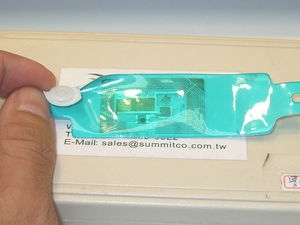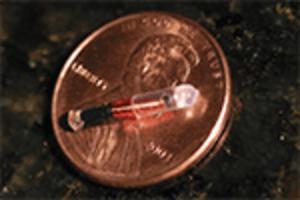Tag You’re It! Check out the list at the bottom of this article, which lists items that Active RFID tags and Passive RFID tags are being used in.
Radio Frequency Identification Tags (RFID) come in two forms: active or passive. Both types are very different from each other in many ways. We will discuss both active and passive types of RFID’s in great detail in this article.
“Radio Frequency Identification (RFID) is a term used to describe any identification device that can be sensed at a distance with few problems of obstruction or mis-orientation. The devices are often referred to ‘RFID tags’ or ‘smart labels’ (idtechex).
RFID Active Tags:
Active RFID tags obtain their power via an internal battery. Their power source is considered to be continuous. They can be accessed up to a range of 100m; however, their “required signal strength” is very low. Active tags can store 128 kb of data and have the ability to also read/write data. Multi-tag reading is available with active tags up to thousands of tags can be recognized.
RFID Passive Tags:
Passive RFID tags are unlike Active tags in many ways. They do not have an internal battery source, so they obtain there power via the transfer of energy from Radio Frequencies that emit from a ‘Reader’. Therefore, passive tags have to be in range of a Reader (also known as ‘Field Reader’) in order to receive power.
Due to the land line type of service power, a passive tags “required signal strength” is very high. The range in which passive tags need to be in order to be able to receive power from the Reader is between 3-5m. Passive tags can only store “128 bytes of read/write data”. However, like active tags – passive tags also have a multi-tag capability, but with only several hundred tags, which have to be at least 3m in range of Reader in order to operate.
Power Of The Reader On RFID Tags:
RFID tags are also known as ‘computer chips’ or ‘chips’ for short. Active RFID tags get there power source through batteries unlike Passive ones whose power comes from a field reader (or reader for short).
RFID field readers are exactly what you see in the entrance/exit of a retail store. We call them ‘metal detectors’. Readers are mandatory in order to use Passive type RFID tags, but while they are not mandatory for Active RFID tags, they can still be used in turning an Active RFID tag on from its sleep mode.
What Readers Do To Passive Tags Verses Active Tags:
RFID readers perform a variety of tasks associated with Passive RFID tags. The reader can turn them off and on, signal the chip to release its stored data to a particular database. Readers also activate the chips to start collecting data.
The only thing a Reader can do with an Active RFID tag is turn it on if it was put on sleep mode.
What Everyday Items Contain Active Tags:
1.) Consumer goods
2.) Vehicles
3.) Car clickers
4.) Postal items
5.) Pharmaceuticals/Healthcare
6.) Cold retail supply chain
7.) Manufacturing parts and tools
8.) Archiving (samples)
9.) Military items
10.) Retail CPG pallet/case
11.) Shelf Edge Labels
12.) Conveyances/Rollcages/ULD/Totes
13.) People (excluding other sectors)
What Everyday Items Contain Passive Tags:
1.) Drugs (and other healthcare)
2.) Consumer goods
3.) Retail apparel
4.) Tires
5.) Vehicles
6.) Books
7.) Postal items
8.) Smart cards/payment key fobs
9.) Air baggage
10.) Passport pages / secure documents
11.) Animals
12.) Military items
13.) Manufacturing parts and tools
14.) Archiving (documents/samples)
15.) Retail CPG pallet/case
16.) Conveyances/Rollcages/ULD/Totes
17.) People (excluding other sectors)
18.) Other tag applications
Sources:
IdTechex
RFID Weblog
RFID Exchange
VeriChip: The Computer Chip In You
Surgeons Leave Behind Surgical Equipment In Patients
Preventative Mad Cow Disease





